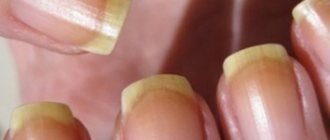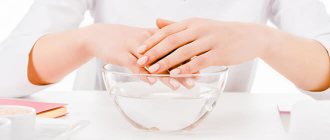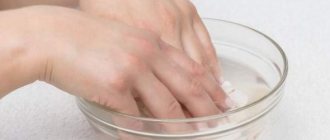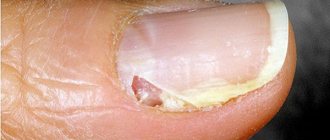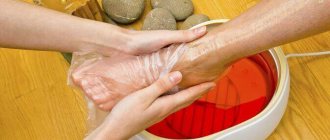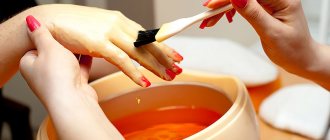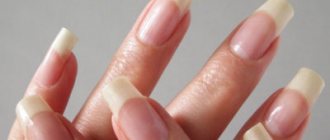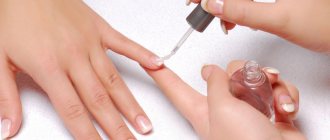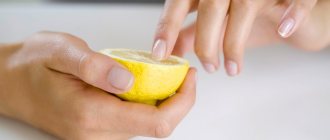Beautiful and well-groomed nails are the dream of any modern woman. In pursuit of well-groomed nails, the fair sex spend a lot of time and money on salon treatments, not even suspecting that an effective remedy for healthy nails is in the refrigerator of every housewife - an ordinary lemon can improve the condition of the nail plate in just a few uses. It has long been known how useful and effective lemon is for nails, so now you can find many recipes for whitening, nourishing and strengthening the nail plate with the help of this citrus.
Beneficial features
Lemon is a storehouse of vitamins and minerals that promote rapid and proper growth of the nail plate. Thanks to the complex action of vitamins C, D, A and E, lemon can strengthen and moisturize the nail plate. It is also recommended to use lemon against nail fungus.
| Vitamins in lemon | Beneficial features |
| Vitamin A | Removes dryness and brittleness, fights thickening along the edges of the nail plate |
| Vitamin E | Strengthens nails, prevents the appearance of hangnails |
| Vitamin C | Prevents peeling and thinning of nails |
| Vitamin D | Promotes rapid growth of the nail plate |
It should be remembered that lemon, like other citrus fruits, contains active elements that sometimes irritate the skin around the nails. Therefore, it is not recommended to apply lemon to your nails every day. It is better to limit the use of this citrus for nail care to once or twice a week, otherwise the nails will begin to peel.
Fighting fungus
In the initial stages of the disease, it is effective to use lemon for toenail fungus, since the acidic environment is unfavorable for the functioning of fungal infections. There are several proven ways to get rid of fungus.
- The first method is the simplest, but no less effective: you need to squeeze out lemon juice and immediately apply it to the skin affected by the fungus. After 15-20 minutes, the lemon juice is thoroughly washed off. This procedure can be done for no longer than two weeks.
- 2-3 drops of lemon oil should be mixed with a couple of drops of glycerin. It is recommended to rub the resulting balm onto the fungus-infected area every night, then put socks on top and leave the balm on your feet overnight.
- You can also try a lemon compress. To do this, cut the lemon into slices and apply it to the nail. Then the infected area is covered with a plastic bag and bandaged. It is recommended to apply the compress at night for 10 days.
- 4-5 drops of lemon juice should be mixed with turmeric until a thick mass is formed. The resulting paste should be applied to the nail with the fungus and then bandage the area. After 25 minutes, you need to remove the bandage.
Treatment prognosis at different stages of nail fungus
The prognosis for treating fungus with lemon is quite optimistic, but subject to the following principles:
- duration of therapy;
- daily procedures;
- complex treatment for advanced forms of onychomycosis;
The prognosis of the disease will be favorable only if treatment is started immediately when the first signs of the disease appear. In addition, after the disappearance of onychomycosis manifestations, it is necessary to follow preventive measures for 1-2 months.
If there are no improvements after treatment with lemon, you should definitely consult a specialist. He will review the treatment regimen and, if necessary, prescribe the use of special antifungal agents.
It is possible to cope with fungus with the help of lemon only if the pathology is at an early stage of development. The use of the drug in such a situation will only help to reduce the lesion, relieve itching and slow down the progression of the disease. Despite this, the likelihood of a relapse of the disease is quite high.
Nail whitening
A whitening nail mask with lemon helps against yellowness and dullness of nails. The fruit is cut into two parts and the nails are dipped into it. After 10-15 minutes, remove the fingertips and rub the remaining juice in a circular motion. After the procedure, the nails are lubricated with cream.
Baths are no less effective. A bath with table vinegar remains popular among girls. For it, 3 tablespoons of vinegar are mixed with 2 tablespoons of lemon juice and 100 ml of water. You need to keep your hands in this solution for no more than 10 minutes, otherwise the bath will harm the skin around the nails.
Strengthening
Often, due to the fragility of the nail plate, it is very difficult for girls to grow their nails to the desired length. Lemon nail baths come to the rescue.
- An iodine bath also helps get rid of hangnails. To prepare it, place 2 tablespoons of lemon juice, 3-4 drops of iodine and 150 g of glycerin in one container, add honey if desired. The resulting solution is then heated. Dip your fingertips into a warm bath and keep in the container for 20-25 minutes. After this, hands should be washed thoroughly with warm water.
- Salt baths themselves are a powerful remedy for brittle nails, and in combination with lemon, the benefits of such a bath increase significantly. Keep your nails in a solution of 2 teaspoons of salt and 4 tablespoons of lemon juice for up to 10 minutes.
- A milk bath will give your nails a well-groomed look. To prepare a bath, add a tablespoon of salt, the juice of half a lemon and 3 tablespoons of honey to 0.5 cups of milk. It is recommended to keep the nails for half an hour; to be effective, this procedure is repeated 2 times a week; already in the second week, the nails will begin to grow faster.
To eliminate brittleness and flaking, a mask with oil and iodine will help. Vegetable oil is heated in a water bath, then a couple of drops of lemon juice and 3-4 drops of iodine are added to it. The resulting warm mixture is applied for 15-20 minutes and then washed off.
The same effect can be achieved by adding a pinch of sea or rock salt to a tablespoon of juice. This mixture is applied only to intact skin and kept for a maximum of 20 minutes, then the mask is thoroughly washed off.
3.Varieties:
3.1.Pavlovsk lemon
The variety was specially bred for growing indoors in the city of Pavlov-on-Oka, and indoor trees are in no way inferior to the best varieties for growing in open ground. The average weight of the fruits of such a tree is 120 - 150 grams, and the record holders reach half a kilogram, and this despite the fact that over the course of several centuries the plants have adapted to low light and the relatively dry atmosphere of living quarters. The leaves are leathery, dark green, up to 15 cm long. Flowering occurs in waves - it will be most abundant in the spring, but individual buds can appear at any time of the year. Fruit may also set throughout the year.
3.2.Meyer lemon
These trees were originally grown in Beijing in indoor conditions and, accordingly, on a par with Pavlovsk, they tolerate all the peculiarities of home life. The variety is distinguished by very high yield, thin-skinned and sweet fruits, although they are medium-sized, round in shape, and orange. Some botanists believe that this species came from crossing a lemon and an orange. The plants have strong shoots bearing glossy dark green leaves up to 12 cm long. The plants are very modest in size and tolerate formative pruning well.
3.3.Genoa
Small evergreen trees with thin, abundantly leafy branches forming a lush crown. The leaves are oblong - oval, green, glossy. The plant tolerates a very wide range of temperatures compared to other varieties. The fruits are oblong, golden-yellow in color, rather dry and contain less juice than most citrus fruits. The tree can bloom and bear fruit abundantly throughout the year.
3.4.Novogruzinsky
Tall plants with light leaves about 12 cm long. Flowers reach 4 cm in diameter, with whitish-lilac petals. This variety is very prolific even at home, although in young plants fruiting occurs later than in many other varieties. The fruits are oblong and round, quite sweet, and have a strong aroma. New Georgian lemon is suitable for growing in rooms with high ceilings, since even with heavy pruning it is a fairly tall tree.
3.5.Tashkent
Another compact tree or shrub suitable for growing indoors. The plants are highly decorative - they have a rounded crown and reach a height of 1.5 - 2 m. The shoots are weakly spiny, branch profusely, and bear alternately widely spaced lanceolate leaves. The leaf blades are glossy, entire or with small teeth, dark green. In autumn, leaves may fall. The flowers are large, white inside, pink outside, collected in axillary inflorescences of 3 - 5 pieces, flowering is very abundant. The fruits are round in shape, orange, reminiscent of an orange.
3.6.Maikop
Compact evergreen trees with high productivity. The plant often does not exceed 2 m in height, and it is easily controlled by pruning. The round, dense crown is formed by abundantly branching thin shoots. The leaves are thick, hard, dark green, on short petioles. The flowers are white, collected in small axillary inflorescences, and have a pleasant aroma. The fruits are oblong, greenish-yellow, with a bumpy surface.
3.7.Kievsky
Spreading evergreen trees up to 2.5 m high with early flowering and fruiting. The plants are distinguished by very large fruits - often the thin branches of these citrus fruits need support so as not to break under the weight of the harvest. The flowers are creamy, fragrant, located in small axillary inflorescences. The fruits are oblong, pear-shaped, golden yellow, lumpy. It is believed that this variety is well suited for growing indoors.
Currently, beautiful variegated varieties of lemons have been bred, which delight not only with fruiting, but also with attractive bright leaves and fruits. The leaf blades of such bushes are dark green with a light white, yellowish or light green border along the edge. The fruits, even fully ripe ones, have thin longitudinal green stripes on the surface.
You might also be interested in:
Orange
Calamondin
Kumquat
Avocado
Lemon and honey are a great combination for nourishing nails
A mask of honey and lemon juice gives your nails an incredible shine. Honey is mixed in equal proportions with juice and applied to the nails for 15-20 minutes. This mixture can be used for compresses. To do this, apply the mask to the cuticle and nails, then put on fabric gloves on top and walk in them for 10-15 minutes.
Lemon juice for nails is one of the most popular remedies, but lemon zest is no less useful. It can be used as a nail mask. To do this, grate the zest on a coarse grater and apply it to the nails. The resulting paste must be rubbed into the nail plate in a circular motion for several minutes. After this, the remaining zest should be washed off and a nourishing cream should be applied to your hands.
Nail baths with citric acid
Deterioration of nails is a problem familiar to most representatives of the fairer sex. There are many reasons for this. And if the problem is not related to internal diseases, then it can be eliminated with the help of baths. Women most often use them to strengthen and whiten nails. Let's find out how citric acid helps with this.
It is a white crystalline substance, highly soluble in ethyl alcohol and water. Citric acid, due to its properties, is classified as a natural antioxidant. This substance was first isolated from lemon juice in the 18th century. But this does not mean that citric acid is only found in lemons. It is a component of other citrus fruits and many berries, for example, black currants and cranberries. It is also found in apples, pine needles, and Chinese lemongrass.
Most often this substance is used in cooking, but it is also in great demand in the field of cosmetology. After all, citric acid has antioxidant and bactericidal properties, stimulates cell renewal, and increases their elasticity. It has a pronounced whitening (depigmenting) effect. The product cares for the nail plate, giving it shine and smoothness. Most often it is included in special products for strengthening nails along with lactic and malic acids.
When starting a course of citric acid baths, keep in mind that they cannot be used often, because the nails may become too soft and lose their strength. Two or maximum three procedures per week will be enough. If there is a need to simply whiten your nails after doing chores at the dacha, then one bath of citric acid will be enough. To do this, dissolve a teaspoon of the product in a glass of heated water, and leave the nails in the bleaching solution for 15 minutes. Then, after drying, you need to grease them with olive oil.
We offer other recipes for citric acid baths:
- With salt. This is a strengthening and at the same time whitening procedure. Dissolve two tablespoons of sea salt and one teaspoon of crystalline substance in half a liter of water. The procedure time is 10 minutes.
- With currants. Mash ½ cup of black currants to a puree, add 50 grams of warm water and an ampoule of vitamin B1. This vitamin stimulates the production of keratin, the main component of nails. Therefore, the bath has general strengthening and whitening properties. You should not keep your nails in it for longer than 15 minutes.
- With iodine. To two glasses of warm water you need to add 4-5 drops of iodine and ½ teaspoon of citric acid.
- With apple juice. Squeeze the juice of one sour apple, add 50 grams of whey and heat it. Keep your nails in the healing liquid for 10-15 minutes.
- With cranberries. Take half a glass of cranberries and puree them. Add the juice of one carrot to it and stir everything thoroughly. Soak your fingertips in this bath for 15-20 minutes. It will give your nails strength, elasticity and shine.
- With soda. Warm up a glass of water. Add half a teaspoon each of baking soda and citric acid.
- With lemon juice. Squeeze the juice of ½ lemon, add a glass of warm water, two ampoules of vitamin B. This procedure is suitable for those nails from which extensions have been removed. Keep your fingertips in the bath for 20 minutes.
- With red pepper. In half a liter of warm water, dilute half a teaspoon of citric acid and a teaspoon of red pepper tincture. The bath evens out the nail plates and accelerates their growth.
- With serum. Heat a glass of homemade whey, add a tablespoon of honey, a teaspoon of citric acid and a couple of drops of lemon essential oil. Thanks to the silicon and calcium in the dairy product and the vitamins in honey, the bath strengthens the nails, gives them shine, and whitens them.
Take care of your hands and nails, and carry out such procedures as preventive measures.
Edited 01/25/2021
Lemon essential oil
Like other essential oils, lemon oil is not used in its pure form; it is added to a base oil; olive oil is often used for this purpose. Before applying a mask with essential oil, you should thoroughly wash your hands with soap.
The base oil must be heated in a water bath. As soon as the temperature of the oil has become slightly higher than body temperature, you need to add 3-4 drops of lemon oil to it. Fingers should be placed in the resulting liquid for 15 minutes. Remaining product can be wiped off with a napkin. This procedure brightens the nails and gives them shine. In addition, lemon essential oil has bactericidal properties. It can be used for cracks or minor damage to the skin.
Lemon for nails is an inexpensive and effective remedy for nourishing and strengthening them, but do not forget about additional factors that affect the condition of the nails. You need to carefully monitor your diet: the diet should consist of fruits, meat, vegetables and seafood. Thanks to a balanced diet and constant care, the effect of using masks and lemon baths will be noticeable after just a few procedures.
